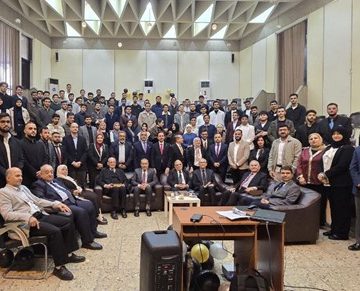The Civil Engineering Department at the College of Engineering, University of Baghdad, held on Thursday 28-11-2024 M.Sc. thesis examination titled:
“Behavior of Composite Reinforced Concrete Circular Columns with GFRP I-Section”
By student Hiba Shihab Ahmed.
The examination committee consisted of:
- Prof. Dr. Nazar K. A. Oukaili University of Baghdad/ College of Engineering (chairman).
- Asst. Prof. Dr. Shatha Dheyaa Mohammed University of Baghdad/ College of Engineering (member)
- Asst. Prof. Dr. Luma Fadhil Hussein Al Mustansiriyah University/ College of Engineering (member)
- Prof. Dr. Abbas A. llawi University of Baghdad/ College of Engineering (supervisor).
- Prof. Dr. Riyadh Hindi University of Baghdad/ College of Engineering (supervisor).
After conducting the public discussion and listening to the student’s defense, the thesis was accepted with an Excellent degree.
The thesis was summarized as follows:
Pultruded materials made of fiber reinforced polymer (FRP) come in a broad range of shapes, such as bars, I-sections, C-sections, and other structural sections. These FRP materials are starting to compete with steel as structural materials because of their high strength, low self-weight, and cheap maintenance costs-especially in corrosive conditions. This study aimed to evaluated the behavior of a new concrete composite column using GFRP (Glass Fiber Reinforced Polymer) I-section as a reinforcement additional to traditional steel bars under different load conditions and compared with reference specimens reinforced once with steel I-sections and other once with traditional reinforced concrete columns. To achieve the aims of this study, nine circular columns with a diameter of (150 mm) and a height of (1000 mm) were cast with compression strength equal to (42.4 MPa) at the test day. The research involved three different types of reinforcement: Hybrid circular columns with GFRP I-section and 1% of the reinforcement ratio of steel bars, Hybrid circular columns with steel I-section and 1% of the reinforcement ratio of steel bars, (where the cross-section area of steel I-section was the same for GFRP), compared with reference column without I-section. This study investigates the ultimate capacity, axial and lateral deformation, and failure mode of the circular column under different loading conditions: concentric, eccentric (with eccentricities of 25 mm) and flexural loading. The results showed that the ultimate capacity of the composite columns using either encased steel I-section or GFRP I-section was higher than the traditional columns under all loading conditions. The concentric tested specimens, with steel I-section and with GFRP I-section, exceeded the ultimate strength of the reference specimen by 8.9% and 2.9%, respectively. Specimens with steel I-section and GFRP I-section achieved 11.9% and 9.7% higher ultimate strength than reference specimens under a compression load of 25mm eccentricity. Specimens with steel I-section and the specimen with GFRP I-section achieved ultimate strengths of 114.3% and 36.6% under flexural load in comparison to reference column. Furthermore, the experimental results indicate that the specimens reinforced with GFRP I-section, showed higher ductility under eccentric (due to axial displacement) and flexural loading. On the other hand, the specimen with steel I-section shows a higher ductility behavior under concentric load.
Also, ABAQUS software was used to model and analyze columns. Considering failure modes, load-deflection curves and a simulation of 50mm eccentric load, which have not been studied in experimental part, was presented. The numerical analysis’s findings agreed well with the results of the experimental part.
A simulation modelling for the column specimens under eccentric load (50 mm) is presented using the finite element method. This simulation has been applied to specimens to get extra points for drawing the interaction diagram of load-moment curves. The results of this simulation indicate that when increase the eccentricity to 50mm the ultimate load of columns decreases. where the capacity of the (reference column, the composite column with steel I-section and the composite column with GFRP I-section) decreased to 67%, 64% and 63% respectively comparing with columns tested under concentric load. Also, the analytical investigation of an interaction diagram can predict the load carrying capacity and bending moment capacity of specimens with good accuracy. And it was noticed a good agreement between the numerical simulation and experimental results.
The study recommended expanded research to fully understand the behavior of such members, more research can be done on similar experiments on GFRP encased concrete columns with varying cross-sections (rectangular and circular), and shapes of embedded structural (tube, channel or angle) sections, so it would provide insight into how building methods could be improved for both cost and efficiency. Additionally, similar studies can be conducted on GFRP-encased concrete columns with different concrete compressive strengths. The study also recommended examining the performance of these columns when longitudinal and transverse steel reinforcement bars are replaced with GFRP bars. Furthermore, examining the impact of the composite column with GFRP sections under various loading conditions, such as combined and dynamic loads. Lastly, the study advised that future research on the slenderness impact of GFRP-encased concrete columns be conducted.







